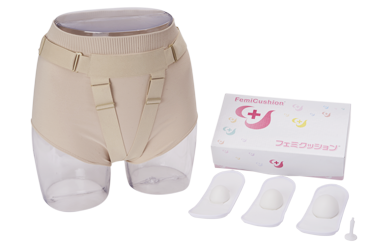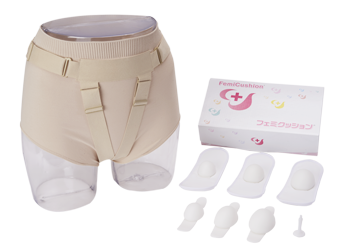
このページの監修医師

このページの監修医師
目次
Uterine prolapse occurs when the uterus descends from its normal position within the vagina but does not protrude outside the vaginal opening. It is specifically diagnosed when the cervix descends below the line connecting the ischial spines (bony prominences within the pelvis) while remaining within the vagina. When uterine prolapse progresses and part or all of the uterus protrudes outside the vagina, it is referred to as uterine prolapse or procidentia.
The prevalence of uterine prolapse, including cases that have progressed from uterine descensus, is estimated to be 14% among women in general, according to research findings. Uterine descensus often presents no noticeable symptoms, leading many individuals to remain undiagnosed. While accurate figures are challenging to obtain, it is believed that the number of women experiencing uterine descensus, the precursor to uterine prolapse, exceeds the 14% reported for uterine prolapse.
Uterine prolapse, also known as pelvic organ prolapse or uterine descensus, is a condition characterized by the descent of the uterus. It is primarily caused by the weakening of the pelvic floor muscles that support the uterus due to various factors. For a more detailed explanation of the symptoms and causes of uterine prolapse, please refer to the article “Uterine Prolapse: Symptoms and Treatment – A Condition Primarily Affecting Middle-Aged and Older Women.”
* Stage One: The uterus descends into the vagina, approaching within 1 cm of the vaginal opening (uterine descensus).
* Stage Two: The uterus descends to the level just inside the vaginal opening, which can cause urinary problems.
* Stage Three: The uterus protrudes outside the vagina.
* Stage Four: The entire uterus protrudes completely outside the vagina.


In the early stages of uterine prolapse or descensus, most individuals experience no symptoms. Often, the condition is first detected during a gynecological examination.
As the uterus descends, the ligaments supporting it may stretch, potentially causing lower abdominal pain. As the condition progresses, a sensation of “something coming out” may be experienced when abdominal pressure increases, such as when standing for long periods, lifting heavy objects, walking, or squatting.
Additionally, during bathing, a “firm, bulging sensation” may be felt when washing the external genitalia, indicating that the cervix is protruding from the vagina. With further progression, the entire uterus, along with the vaginal wall, may descend, potentially pulling down surrounding organs like the bladder and rectum. This can lead to a feeling of “something being caught between the legs” or a sensation of “something going in when sitting and coming out when standing,” increasing discomfort.
Friction with underwear may cause pain and bleeding, and vaginal discharge may increase, become reddish, or develop pus. Difficulty with bowel movements and urination, as well as urinary incontinence, may also occur, significantly impacting quality of life.
While the medical departments responsible for treating conditions involving the uterus, bladder, small intestine, and large intestine have traditionally varied, a specialized field called “urogynecology” has emerged in recent years, combining gynecology and urology. This field focuses on the diagnosis and treatment of female pelvic floor disorders, including pelvic organ prolapse and female urinary incontinence.
If you experience any symptoms, it is advisable to consult a specialist in urogynecology or female urology before the condition progresses.
Symptoms such as bleeding, increased vaginal discharge, itching, pain, dysuria (painful urination), urinary urgency, and a feeling of incomplete bladder emptying can also indicate conditions other than uterine prolapse. These symptoms may also be present in cases of uterine cancer, candidiasis (yeast infection), cystitis (bladder infection), and other infections. Therefore, it is essential to seek medical attention promptly if you notice anything unusual.
The pelvis contains muscles (pelvic floor muscles) that support organs such as the uterus, bladder, and rectum, preventing them from being pushed out of the pelvis due to abdominal pressure. Uterine prolapse occurs when these pelvic floor muscles weaken, causing the uterus and vagina to descend.
Various factors can contribute to the weakening of the pelvic floor muscles, including:
* Childbirth
* Aging and menopause
* Obesity
* Habitual straining during bowel movements (constipation)
* Weak constitution
* Chronic coughing (bronchitis or asthma)
* Prolonged standing at work
* Jobs involving heavy lifting
* History of pelvic surgery
Childbirth is a particularly common cause. Most individuals who develop uterine prolapse have a history of childbirth, with the risk increasing with the number of vaginal deliveries. However, it is rare for uterine prolapse to occur immediately after delivery, and onset typically occurs around the age of 60, after menopause.
Uterine prolapse is more common after menopause due to the decline in female hormones, which weakens supporting tissues like ligaments and pelvic floor muscles. Other factors, such as obesity, chronic constipation, coughing, and occupations involving heavy lifting, can increase abdominal pressure and contribute to uterine prolapse.
The following four measures are considered effective in preventing uterine prolapse:
* Avoid strenuous childbirth
* Strengthen pelvic floor muscles
* Maintain a healthy weight
* Improve bowel habits
Advanced maternal age, multiple births, and difficult labor increase the risk of uterine prolapse. Therefore, it is advisable not to insist on vaginal delivery and to consider opting for a cesarean section. Cesarean delivery is associated with a lower risk of uterine prolapse compared to vaginal delivery.
Since uterine prolapse is caused by the weakening or damage of pelvic floor muscles, strengthening these muscles can help prevent the condition. It is important to start early and maintain a consistent exercise routine, as strengthening the muscles after the onset of uterine prolapse may not completely reverse the condition.
Obesity and increased visceral fat can compress organs like the uterus and bladder from within the abdominal cavity, leading to uterine prolapse. Maintaining a balanced diet and engaging in regular exercise can help prevent obesity.
Straining during bowel movements due to constipation increases abdominal pressure and elevates the risk of uterine prolapse. Drinking plenty of fluids, consuming a high-fiber diet, and engaging in regular exercise can help improve and prevent constipation. If you experience chronic constipation that does not improve with lifestyle changes, consult a gastroenterologist.
Treatment for uterine prolapse varies depending on the severity of the symptoms.
In mild cases, pelvic floor muscle training to strengthen weakened pelvic floor muscles, along with addressing issues like obesity and constipation, may improve the condition.
If the uterus is partially or completely prolapsed, the following treatments are typically performed:
A device called a pessary is inserted into the vagina to reposition the uterus within the pelvis and prevent further prolapse. Since this involves inserting a foreign object into the vagina, symptoms such as vaginitis, increased vaginal discharge, and bleeding may occur. Therefore, regular check-ups with a healthcare professional are necessary for appropriate management. To prevent complications, pessaries need to be replaced periodically.
Surgical intervention is used for fundamental improvement. There are several surgical options, including removing the prolapsed uterus through the vagina, suturing the loosened areas (such as the bladder and rectal walls), reinforcing the vaginal wall with mesh made of artificial material, and closing the vagina.
FemiCushion is a new medical device designed for the prevention and treatment of pelvic organ prolapse, including uterine prolapse, cystocele, rectocele, and enterocele.
It is suitable for those who:
* Cannot use ring pessaries
* Cannot undergo surgery due to underlying health conditions
* Have difficulty visiting the hospital regularly
FemiCushion works by supporting the prolapsed organs. With the prolapsed organs returned to their normal position within the vagina, the cushion covers the vaginal opening, while the holder and supporter lift and maintain the organs in place. It can be worn as needed by the user.
In addition to providing immediate relief from symptoms, FemiCushion helps prevent organ prolapse even under abdominal pressure. It is washable and reusable, and its design resembles underwear, making it discreet and unlikely to be recognized as a medical device by others.

永尾 光一 先生
一般社団法人日本精索静脈瘤協会 理事長
医療法人社団マイクロ会 理事長
銀座リプロ外科 院長
昭和大学にて形成外科学を8年間専攻。その後、東邦大学で泌尿器科学を専攻し、形成外科・泌尿器科両方の診療科部長を経験する(2つの基本領域専門医を取得)。得意分野はマイクロサージャリーをはじめとする生殖医学領域の形成外科的手術。泌尿器科医の枠を超えた細やかな手術手技と丁寧な診察で、様々な悩みを抱える患者さんから高い信頼と評価を得ている。

株式会社三井メディカルジャパン 代表取締役
三井 桂子
株式会社三井メディカルジャパン 代表取締役。日本における女性疾患についての認知や理解度の低さに危機感をおぼえ、医療機器開発に着手。子宮脱をはじめとする骨盤臓器脱の治療に用いる「フェミクッション」を開発し、三井メディカルジャパンを通じて発売。
目次1 三井社長についての質問2 フェミクッション開発経緯3 三井社長の想い4 フェミクッションの効果・優位性4.1 当社の提携医療機関5 今後の展望6 患者さんへのメッセージ 三井社長についての質問 本日は、三井メ…
続きを読む50代を迎えて精神的な不調や腟の違和感が表れ始め、「更年期症状ではないか」と不安を感じていませんか。 エストロゲン(女性ホルモン)低下は加齢といった原因で起こり、多くの女性がさまざまな症状を経験します。…
続きを読む「子宮脱のような症状があるけれど、何科を受診すれば良いかわからない」とお困りではありませんか。 近年、女性特有の悩みである子宮脱のような骨盤臓器脱を治療できる診療科が増えてきています。しかし、骨盤臓器…
続きを読むFemicushion™: UNICAMP – Urology Department – Campinas – Brazil 目次1 要旨1.1 導入と目的1.2 患者 […]
続きを読むスターターキット ライトネット購入限定

まずは試してみたい
という⽅に!
セット内容
・サポーター1枚(ミディベージュサポーター)
・クッション 3個(S・M・L各サイズ1個)
・布製ホルダー(フリーサイズ3枚)
・洗浄栓
※スターターキット ライトをご選択の方はミディベージュサポーターのみとなります。
スターターキット

普段の⽣活でしっかり
使いたい⽅に!
セット内容
・サポーター1枚(次の項目で種類・サイズを選択ください)
・クッション 6個(S・M・L各サイズ2個)
・布製ホルダー(フリーサイズ3枚)
・洗浄栓
※コットンの特注サイズは現在在庫切れです。